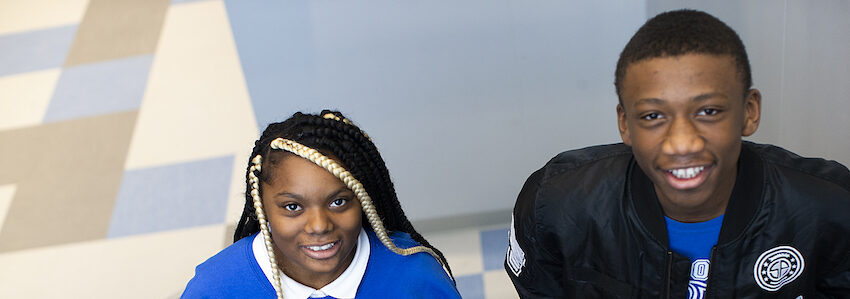
Teachers, raise your hand if your classroom has at least one student who is practicing foundational skills. Keep them up if it’s five or more students. Ten or more? Most students? Yes, we see your hands. Hi! We’re waving back at you!
In our math classrooms, fractions were when we felt it. How were we supposed to teach dividing fractions when some of our learners couldn’t add fractions? When some of our learners didn’t know what fractions truly are?
Whether it’s math or reading, science or social studies, it’s almost impossible to find a classroom where all learners are exactly where they “should” be. But when we remember that all learners grow at different paces, and that children of the same age aren’t necessarily all ready to learn the same things, we begin to have more empathy for our students, for their previous teachers, and for ourselves!
We know academic growth happens when learners receive rich exposure to grade-level content, yet we must face the facts: our learners have gaps that need addressing. Teachers, we don’t need convincing. We need know-how!
The Transformative Ten: Stepping stones to high growth for all
Former NWEA education researcher Chase Nordengren embarked on a study of a school that defied the odds and consistently produced high student growth year after year. Hundreds of hours of observation, interviews, research, and MAP® Growth™ data led him to recommend ten concrete strategies teachers can take to support student growth. We’re calling these the Transformative Ten:
- Provide supplemental learning time for targeted retrieval practice
- Mix whole-group, small-group, and individual activities
- Adjust student groups in real time
- Share students and strategies within a grade level
- Differentiate tasks within a unit
- Provide targeted practice for foundational skills
- Teach from multiple standards at once
- Create opportunities for self-directed learning
- Use student discourse as formative assessment
- Explicitly teach academic vocabulary
Strategy 6 asks educators to make intentional, focused time for practicing foundational skills that are necessary building blocks, while avoiding getting stuck in past years’ standards. It’s undeniable: this year’s standards + every previous year’s standards = our work cut out for us. But, luckily, one district’s proven methods are here to add new support.
Practicing foundational skills: 3 myths to bust the stress
Half of the stress of providing targeted foundational support is not necessarily the doing of it; it’s the looming omnipresence of “My students need review!” There are many teachers who can reteach previous years’ concepts with fluidity and engagement. In fact, we may have favorite review lessons. But this haunting idea that students are perpetually behind plagues our teacher brains all year long until, surprise! New year, new students, same stressful specter.
It is an educational reality that we need learners to meet certain targets by certain points in the year. But the sooner we accept that “review” is actually a natural part of the learning progression—especially after the pandemic—the less stressed we as educators will be. And let’s face it: we’re much better at our jobs when we’re a bit less tense.
Myth #1: “But they learned this already”
Not necessarily. Raise your hand if you ever had to skip standards because your school year ran short or because you were, you guessed it, reteaching? Raise your hand if you had to abandon at least one standard because “power standards” needed your attention?
Or maybe a student switched schools or teachers while learning a new concept. Maybe they had something going on at home, like the death of a pet, a new sibling, or a move. Perhaps COVID massively interrupted their learning of a foundational concept or they never fully understood a concept in the first place because their brains simply weren’t ready.
The good news is, each day, you’re dealing with older, more developed brains. Just-in-time support like a mini lesson on “What exactly is a fraction?” could be exactly what they need to ignite their understanding—and even unlock old learning memories that just now make sense to them.
Myth #2: “Nothing truly ‘learned’ needs to be retaught”
Hmm. Maybe. The science of forgetting is complex. If we had to retake physics, for example, we’d have some relearning to do, because it’s not a subject we use every day. Not because we didn’t know it in the first place, but because the neural pathways in our brain need reminding of what they understood long ago. Sometimes, we forget procedures and need simple reminding of the concepts behind them.
Imagine a student who “doesn’t remember” how to turn fractions into decimals. It turns out, their previous teacher used money manipulatives to teach this concept and the student hasn’t dealt with physical money since. A simple mini lesson linking money to the larger concept may be all they need. Their older brain will likely re-meet the concept with a bit more of a foothold.
Of course, sometimes educators correctly assess that a student who can’t read a paragraph of text doesn’t need “reminding” of phonics; it’s that there are gaps in the learning that may need deeper intervention.
Myth #3: “My exceptional students will be underserved by revisiting previous years’ content”
Here’s the truth: if all we ever did was review, we would underserve all our learners. Research repeatedly shows that all learners need rigorous instruction of on-grade-level content. Yet it’s also true that what’s good for one learner is good for everyone, like written instructions benefitting more than just those with hearing impairments. This Universal Design for Learning (UDL) approach is not only compassionate; it’s also common sense. In fact, many tips on supporting kindergarten math students would support first- and second-graders as well.
What we label as “reteaching” can become reconceptualizing, reconnecting, and reinvigorating. This benefits all the learners in the classroom.
5 tips for practicing foundational skills and filling in the gaps
Educators, now that we’ve taken some deep breaths and know we’re in this together, here are five tips for supporting your learners with targeted foundational skills support.
Tip #1: Normalize review by carving out consistent whole-group time
Looking back on the school year, wouldn’t it be great if there were a consistent review time as a “catch-all” for those gaps you notice during formative assessment? Students do well with routine—and they love a good hashtag—so maybe it’s time to riff on #ThrowbackThursday.
Perhaps each Thursday, you protect time for a twenty-minute whole-group review session on a deeper, “older” concept that would benefit all voices in the room. Consider going full old school and bringing back physical or digital manipulatives that remind them of their younger classrooms.
Elevate this to a pro tip by bringing it back around on Monday for a quick review. Recalling the skill after the weekend is great practice for retention.
Tip #2: Invite students to teach
Sometimes, the best teachers for your students are other students. Let’s return to our fraction example. Perhaps a couple of learners need a review on adding fractions. Instead of asking students to explain the concept, try this workflow:
- Write student responses to two lists: List A: “Student errors when adding fractions.” List B: “Math vocab words you might hear when adding fractions.”
- Invite a student to the board. Their job is to explain one student error when adding fractions (from list A) using at least one math vocab word (from list B).
- Invite another student to be the elaborator, that is, the person who explains, clarifies, or corrects any instruction from the previous student. Bonus points if they include another student error or math vocab word from your lists.
- Invite a third student (perhaps one who rates themselves as shaky on the concept) to recap what the two students just taught. They can pick what explanation made more sense to them, or they can create a mashup.
- Take notes on your students to help inform your decision-making for upcoming small groups. Maybe student 1 was confident but had an error that needs addressing, for example.
When students teach each other, they reinforce their own understanding, reveal their misconceptions, and deepen conceptual connections for all involved.
Tip #3: Keep your small groups fresh and flexible
Sometimes targeted practice with foundational skills will be more needed by a subset of students, who then benefit more from the smaller setting. My colleague Tatiana Ciccarelli champions flexible grouping in “3 ways to use flexible grouping in real time to support student growth,” where she offers three steps to shift the small-group mindset from “These are our low-performing kids, our middle kids, and our high kids” to “This is where the student will work best right now. I, as the teacher, am flexible and prepared to move them to a different group if I need to.”
The trick is to stay flexible, both in your groups and with yourself. Tatiana encourages teachers to make ever-evolving small groups that fit the learning goal, and she reminds us to feel free to make last-minute switches. Our students and their relationship to material is always changing, so their groupings should, too.
Tip #4: Remove “Right?” from your vocabulary
Once you start noticing this one, you’ll hear it everywhere.
“Right?” is an innocuous little word that we often thoughtlessly use as a synonym for, “Are you with me?” However, this is a cue word for our students to pretend they understand or remember what you’re unintentionally labeling as obvious. Students (and your adult friends!) may take this to mean, “Oh, I’m supposed to already understand, even though I’m already lost. This is beneath her to explain, so I will ask no questions.”
Ask your students to help you with this. They will surely love to vigilantly tally each time you slip up.
Tip #5: Leverage a digital tool
If your school uses MAP Growth, one more way to make your assessment data work for you is to pair it with a supplemental digital tool. Many of our instructional connections funnel targeted practice to students based on their reading and math scores, accessing a level of personalized, differentiated practice that gives teachers back valuable searching-for-that-perfect-learning-activity time.
An opportunity for depth
As teachers, we regularly encounter skill sets that build on and draw from one another. Thus, it’s important that we identify and support our students when something is missing. As we dismiss the “they should be here by now” mindset (when did that ever help anybody?), we free up our energy to explore practicing foundational skills as an opportunity to deepen connections that last longer and longer each time.







